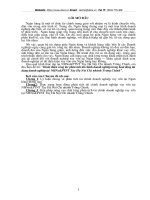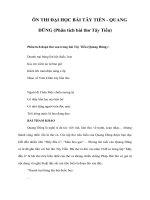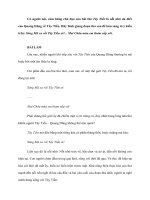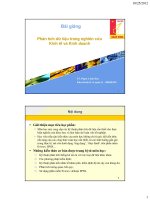Phân tích bài đọc trong toiec12 pot
Bạn đang xem bản rút gọn của tài liệu. Xem và tải ngay bản đầy đủ của tài liệu tại đây (43.37 KB, 8 trang )
(c) need (d) change
24. The word "diffuses" in line 19 is closest in meaning to
(a) yields (b) starts
(c) surfaces (d) travels
25. What happens to nitrogen in body tissues if a diver ascends too quickly?
(a) it forms bubbles.
(b) It goes directly to the brain
(c) It is reabsorbed by the lungs
(d) It has a narcotic effect
26. The word "they" in line 21 refers to
(a) joints (b) pains
(c) bubbles (d) tissues
27. The word "rupture" in line 26 is closest in meaning to
(a) hurt (b) shrink
(c) burst (d) stop
28. It can be inferred from the passage that which of the following
presents the greatest danger to a diver?
(a) pressurized helium
(b) Nitrogen diffusion
(c) Nitrogen bubbles
(d) An air embolism
29. What should a diver do when ascending?
(a) Rise slowly
(b) Breathe faster
(c) Relax completely
(d) Breathe helium
Questions 30-39
Each advance in microscopic technique has provided scientists with new
perspectives
on the function of living organisms and the nature of matter itself. The invention
of the visible-light microscope late in the sixteenth century introduced
a previously unknown
Line realm of single-celled plants and animals. In the twentieth century, electron
microscopes
(5) have provided direct views of viruses and minuscule surface structures. Now
another
type of microscope, one that utilizes x-rays rather than light or electrons, offers a
different way of examining tiny details; it should extend human perception still
farther
into the natural world.
The dream of building an x-ray microscope dates to 1895 ; its development,
however,
(10) was virtually halted in the 1940's because the development of the electron
microscope
was progressing rapidly. During the 1940's, electron microscopes routinely
achieved
resolution better than that possible with a visible-light microscope, while the
performance of x-ray microscopes resisted improvement. In recent years,
however,
interest in x-ray microscopes has revived, largely because of advances such as
the
(15) development of new sources of x-ray illumination. As a result, the brightness
available
today is millions of times that of x-ray tubes, which, for most of the century,
were the
only available sources of soft x-rays.
The new x-ray microscopes considerably improve on the resolution
provided by optical microscopes. They can also be used to map the
distribution of certain chemical elements.
(20) Some can form pictures in extremely short times ; others hold the promise of
special
capabilities such as three-dimensional imaging. Unlike conventional electron
microscopy,
x-ray microscopy enables specimens to be kept in air and in water, which means
that
biological samples can be studied under conditions similar to their natural state.
The
illumination used, so-called soft x-rays in the wavelength range of twenty to
forty
(25) angstroms(an angstrom is one ten-billionth of a meter), is also sufficiently
penetrating
to image intact biological cells in many cases. Because of the wavelength of the
x-rays
used, soft x-ray microscopes will never match the highest resolution possible
with
electron microscopes. Rather, their special properties will make possible
investigations
that will complement those performed with light- and electron-based
instruments.
30. What does the passage mainly discuss?
(a) The detail seen through a microscope
(b) Sources of illumination for microscopes
(c) A new kind of microscope
(d) Outdated microscopic techniques
31. According to the passage, the invention of the visible-light microscope
allowed scientists to
(a) see viruses directly
(b) develop the electron microscope late on
(c) understand more about the distribution of the chemical elements
(d) discover single-celled plants and animals they had never seen before
32. The word "minuscule" in line 5 s closest in meaning to
(a) circular (b) dangerous
(c) complex (d) tiny
33. The word "it" in line 7 refers to
(a) a type of microscope
(b) human perception
(c) the natural world
(d) light
34. Why does the author mention the visible-light microscope in the first
paragraph?
(a) To begin a discussion of sixteenth-century discoveries
(b) To put the x-ray microscope in a historical perspective
(c) To show how limited its uses are
(d) To explain how it functioned
35. Why did it take so long to develop the x-ray microscope?
(a) Funds for research were insufficient.
(b) The source of illumination was not bright enough until recently.
(c) Materials used to manufacture x-ray tubes were difficult to obtain
(d) X-ray microscopes were too complicated to operate.
36. The word "enables" in line 22 is closest in meaning to
(a) constitutes (b) specifies
(c) expands (d) allows
37. The word "Rather" on line 28 is closest in meaning to
(a) Significantly (b) Preferably
(c) Somewhat (d) Instead
38. The word "those" in line 29 refers to
(a) properties (b) investigations
(c) microscopes (d) x-rays
39. Based on the information in the passage, what can be inferred
about x-ray microscopes in the future?
(a) They will probably replace electron microscopes altogether.
(b) They will eventually be much cheaper to produce than they are now.
(c) They will provide information not available from other kinds of
microscopes.
(d) They will eventually change the illumination rage that they now use.
Questions 40-50
Perhaps the most striking quality of satiric literature is its freshness, its
originality of perspective. Satire rarely offers original ideas. Instead, it
presents the familiar in a new
form. Satirists do not offer the world new philosophies. What they do is look at
Line familiar conditions from a perspective that makes these conditions seem foolish,
(5) harmful, or affected. Satire jars us out of complacence into a pleasantly shocked
realization that many of the values we unquestioningly accept are false. Don
Quixote
makes chivalry seem absurd ; Brave New World ridicules the pretensions of
science ; A
Modest Proposal dramatizes starvation by advocating cannibalism. None of
these ideas
is original. Chivalry was suspect before Cervantes, humanists objected to the
claims of
(10) pure science before Aldous Huxley, and people were aware of famine before
Swift. It
was not the originality of the idea that made these satires popular. It was the
manner of expression, the satiric method, that made them
interesting and entertaining. Satires are
read because they are aesthetically satisfying works of art, not because they are
morally wholesome or ethically instructive. They are stimulating
and refreshing because with
(15) commonsense briskness they brush away illusions and secondhand opinions.
With
spontaneous irreverence, satire rearranges perspectives, scrambles familiar
objects into
incongruous juxtaposition, and speaks in a personal idiom instead of abstract
platitude.
Satire exists because there is need for it. It has lived because readers
appreciate a
refreshing stimulus, an irreverent reminder that they live in a world of
platitudinous
(20) thinking, cheap moralizing, and foolish philosophy. Satire serves to prod people
into an
awareness of truth, though rarely to any action on behalf of truth. Satire tends to
remind people that much of what they see, hear, and read in popular media is
sanctimonious, sentimental, and only partially true. Life resembles in only a
slight
degree the popular image of it. Soldiers rarely hold the ideals that movies
attribute to
(25) them, nor do ordinary citizens devote their lives to unselfish service of
humanity.
Intelligent people know these things but tend to forget them when they do not
hear
them expressed.
40. What does the passage mainly discuss?
(a) Difficulties of writing satiric literature
(b) Popular topics of satire
(c) New philosophies emerging from satiric literature
(d) Reasons for the popularity of satire
41. The word "realization" in line 6 is closest in meaning to
(a) certainty (b) awareness
(c) surprise (d) confusion
42. Why does the author mention Don Quixote, Brave New World, and A
Modest Proposal
in lines 6-8?
(a) They are famous examples of satiric literature.
(b) They present commonsense solutions to problems.
(c) They are appropriate for readers of all ages.
(d) They are books with similar stories.
43. The word "aesthetically" in line 13 is closest in meaning to
(a) artistically (b) exceptionally
(c) realistically (d) dependably
44. Which of the following can be found in satiric literature?
(a) Newly emerging philosophies
(b) Odd combinations of objects and ideas
(c) Abstract discussion of morals and ethics
(d) Wholesome characters who are unselfish
45. According to the passage, there is a need for satire because people need to b
(a) informed about new scientific developments
(b) exposed to original philosophies when they are formulated
(c) reminded that popular ideas are often inaccurate
(d) told how they can be of service to their communities
46. The word "refreshing" in line 19 is closest in meaning to
(a) popular (b) ridiculous
(c) meaningful (d) unusual
47. The word "they" in line 22 refers to
(a) people (b) media
(c) ideals (d) movies
48. The word "devote" in line 25 is closest in meaning to
(a) distinguish (b) feel affection
(c) prefer (d) dedicate
49. As a result of reading satiric literature, readers will be most likely to
(a) teach themselves to write fiction
(b) accept conventional points of view
(c) become better informed about current affairs
(d) reexamine their opinions and values
50. The various purposes of satire include all of the following EXCEPT
(a) introducing readers to unfamiliar situations
(b) brushing away illusions
(c) reminding readers of the truth
(d) exposing false values
answers
Test 1
1. A 2. C 3. B 4. A 5. D 6. D 7. B 8. B 9. D 10. A
11. D 12. C 13. C 14. C 15. B 16. B 17. D 18. B 19. B 20. C
21. B 22. B 23. C 24. B 25. B 26. C 27. A 28. D 29. D 30. A
31. A 32. A 33. B 34. A 35. B 36. D 37. B 38. A 39. C 40. A
41. A 42. B 43. A 44. B 45. D 46. B 47. D 48. D 49. B 50. D
Test 2
1. D 2. C 3. A 4. D 5. A 6. D 7. C 8. B 9. A 10. D
11. B 12. B 13. D 14. D 15. B 16. B 17. A 18. C 19. C 20. D
21. A 22. D 23. B 24. C 25. D 26. A 27. C 28. B 29. D 30. B
31. C 32. C 33. C 34. D 35. B 36. A 37. A 38. B 39. A 40. C
41. C 42. B 43. A 44. C 45. D 46. D 47. D 48. A 49. D 50. C
Test 3
1. B 2. C 3. C 4. C 5. D 6. B 7. A 8. D 9. A 10. D
11. C 12. A 13. D 14. C 15. C 16. B 17. D 18. B 19. D 20. A
21. B 22. B 23. B 24. C 25. C 26. A 27. D 28. D 29. A 30. D
31. D 32. D 33. A 34. A 35. A 36. C 37. C 38. D 39. A 40. B
41. D 42. C 43. B 44. B 45. C 46. B 47. D 48. D 49. A 50. C
Test 4
1. B 2. C 3. D 4. C 5. B 6. C 7. B 8. A 9. C 10. B
11. C 12. D 13. D 14. D 15. C 16. C 17. A 18. B 19. B 20. A
21. C 22. D 23. B 24. C 25. A 26. D 27. A 28. B 29. A 30. C
31. D 32. B 33. A 34. B 35. B 36. C 37. C 38. A 39. A 40. B
41. B 42. B 43. B 44. A 45. B 46. C 47. A 48. A 49. C 50. C
Test 5
1. B 2. C 3. A 4. B 5. D 6. B 7. C 8. C 9. D 10. B
11. C 12. B 13. B 14. B 15. C 16. D 17. D 18. A 19. C 20. B
21. B 22. A 23. D 24. C 25. D 26. A 27. B 28. A 29. A 30. C
31. B 32. C 33. A 34. B 35 A 36. B 37. A 38. B 39. C 40. D
41. A 42. A 43. C 44. B 45. C 46. C 47. A 48. D 49. B 50. A
Test 6
1. C 2. D 3. B 4. B 5. D 6. C 7. B 8. A 9. C 10. D
11. C 12. B 13. A 14. C 15. D 16. A 17. D 18. A 19. B 20. A
21. B 22. D 23. A 24. D 25. A 26. C 27. D 28. C 29. A 30. B
31. D 32. A 33. D 34. C 35. D 36. B 37. B 38. D 39. D 40. A
41. B 42. B 43. D 44. B 45. A 46. D 47. D 48. A 49. B 50. C
Test 7
1. B 2. A 3. B 4. B 5. D 6. C 7. B 8. C 9. C 10. D
11. B 12. B 13. A 14. C 15. C 16. D 17. B 18. C 19. D 20. A
21. B 22. B 23. A 24. B 25. D 26. D 27. C 28. B 29. A 30. C
31. A 32. C 33. B 34. D 35. A 36. A 37. D 38. A 39. B 40. C
41. D 42. B 43. C 44. A 45. A 46. B 47. D 48. C 49. A 50. D
Test 8
1. A 2. B 3. A 4. D 5. B 6. A 7. D 8. A 9. B 10. B
11. D 12. B 13. C 14. D 15. B 16. B 17. A 18. D 19. C 20 D
21. C 22. B 23. C 24. D 25. B 26. D 27. A 28. D 29. D 30. C
31. C 32. B 33. D 34. D 35. A 36. A 37. A 38. D 39. B 40. C
41. D 42. A 43. D 44. B 45. B 46. B 47. B 48. C 49. D 50. D
Test 9
1. A 2. A 3. C 4. B 5. A 6. C 7. C 8. B 9. B 10. A
11. A 12. A 13. C 14. A 15. C 16. A 17. C 18. B 19. A 20. B
21. A 22. B 23. A 24. A 25. C 26. C 27. D 28. A 29. C 30. A
31. A 32. D 33. C 34. B 35. B 36. D 37. B 38. B 39. D 40. A
41. A 42. D 43. A 44. C 45. C 46. B 47. B 48. D 49. C 50. B
Test 10
1. A 2. C 3. D 4. C 5. D 6. B 7. B 8. A 9. A 10. C
11. B 12. D 13. D 14. B 15. A 16. A 17. D 18. C 19. D 20. A
21. B 22. D 23. A 24. D 25. A 26. C 27. C 28. D 29. A 30. C
31. D 32. D 33. A 34. B 35. B 36. D 37. D 38. B 39. C 40. D
41. B 42. A 43. A 44. B 45. C 46. D 47. A 48. D 49. D 50. B









